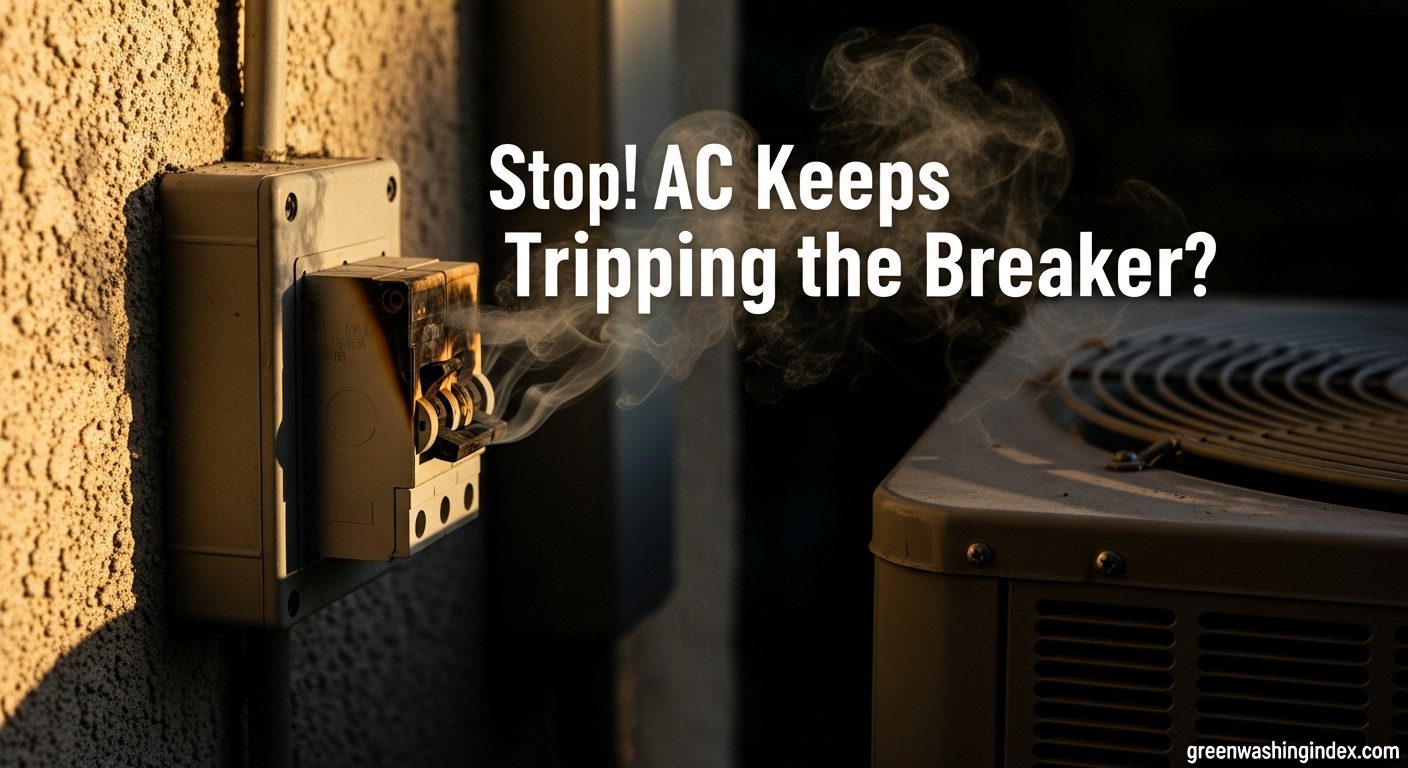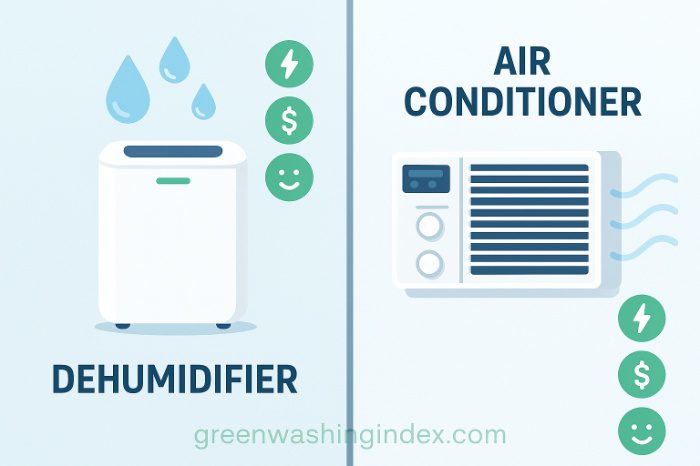

Sticky, uncomfortable air making your home feel like a swamp? You’re not alone – millions of homeowners struggle with the dehumidifier versus AC dilemma every summer. High humidity doesn’t just make you uncomfortable – it can damage your home, trigger allergies, and skyrocket your energy bills when you use the wrong solution.
While air conditioners cool AND remove some moisture, dehumidifiers are 3-5x more energy-efficient for humidity control alone. The best choice depends on your specific needs: temperature control, humidity levels, and budget. In this comprehensive guide, you’ll learn exactly how each system works, see real dehumidifier vs AC energy consumption comparisons, discover when to use one or both, and get specific product recommendations for different scenarios.
Understanding the fundamental differences between these two appliances is crucial for making the right choice for your home comfort needs in 2025.
Dehumidifiers operate on a simple principle: they draw humid air over refrigerated coils, causing moisture to condense into water droplets. This water collects in a tank or drains continuously, while the now-dry air is slightly reheated and returned to your room. The key point? Dehumidifiers don’t significantly change room temperature – they purely focus on moisture removal.
Air conditioners work differently. They remove heat from indoor air by passing it over evaporator coils filled with refrigerant. As a byproduct of this cooling process, moisture condenses and is expelled outside. This dual function makes ACs versatile but less efficient when you only need dehumidification.
The fundamental distinction lies in their primary objectives:
| Feature | Dehumidifier | Air Conditioner |
| Primary Function | Remove moisture | Cool air |
| Temperature Impact | Slight increase (1-2°F) | Significant decrease |
| Energy Usage | 300-700 watts | 1,000-3,500 watts |
| Humidity Control | Precise (adjustable RH%) | Indirect (while cooling) |
| Best Use Case | Damp, cool spaces | Hot, humid environments |
When comparing air conditioner dehumidifier running costs, the financial implications extend beyond just the purchase price.
In 2025, installation costs vary dramatically based on the system type:
Dehumidifier Installation:
Air Conditioner Installation:
The cost to run dehumidifier vs air conditioner shows a clear winner for humidity-only control:
For a typical summer month running 8 hours daily:
Dehumidifiers require minimal maintenance:
Air conditioners need more attention:
Understanding when a dehumidifier or AC for humidity control makes more sense can save you hundreds in energy costs annually.
Coastal regions face unique challenges in 2025:
In these areas, dehumidifiers excel because they:
Certain spaces naturally accumulate moisture:
These areas benefit from dedicated dehumidification rather than cooling.
Maintaining proper humidity levels (30-50%) with a dehumidifier:
Sometimes cooling is essential, making an AC the obvious choice for your home comfort needs.
In regions where temperatures regularly exceed 80°F with high humidity, air conditioners provide:
Central air conditioning systems offer:
Today’s air conditioners include specialized modes:
Using dehumidifier and air conditioner together creates the most comfortable and efficient home environment in many situations.
When outdoor humidity exceeds 70% regularly:
The dehumidifier AC combo benefits include:
For best results:
Pro Tip: The EPA recommends maintaining indoor relative humidity between 30% and 50%, ideally closer to 45% for optimal comfort and health.
Based on extensive research and user feedback in 2025, here are our top recommendations for various scenarios.
Industrial-strength moisture removal for challenging spaces.
Perfect for basements, crawl spaces, and whole-house applications.
The ALORAIR 120 PPD stands as the ultimate solution for serious moisture problems in 2025. This commercial-grade unit tackles the toughest humidity challenges with remarkable efficiency.
Key Performance Features:
Why It Excels in Basements:
The unit’s metal construction and auto-defrost system make it ideal for challenging environments. Unlike standard dehumidifiers that struggle in cold basements, the ALORAIR maintains consistent performance year-round. The MERV-1 filter protects internal components from dust, extending the unit’s lifespan significantly.
Installation and Operation:
Setting up the ALORAIR requires minimal effort despite its commercial-grade capabilities:
Real-World Performance:
Users report dramatic improvements in air quality within days. One homeowner noted their 1940s house lost its persistent musty smell completely after two weeks of operation. Another user successfully maintained 40% humidity in a previously damp cellar for over a year without intervention.
High-efficiency cooling with excellent dehumidification capabilities.
Ideal for whole-room climate control without ductwork.
The Pioneer Diamante Series revolutionizes home climate control by seamlessly combining cooling, heating, and dehumidification in one efficient package.
Advanced Climate Control:
Installation Flexibility:
The complete kit includes everything needed for installation:
Dehumidification Excellence:
What sets the Pioneer apart is its intelligent dehumidification mode. Unlike traditional window AC units that only dehumidify while cooling, this system can remove moisture without overcooling your space. The four operating modes (cooling, heating, dehumidification, ventilation) provide complete climate control flexibility.
User Experience:
Homeowners praise the intuitive controls and scheduling features. The whisper-quiet operation makes it perfect for bedrooms, while the efficient performance keeps energy bills manageable. One user reported perfect temperature and humidity control in their home office, enabling comfortable work-from-home conditions year-round.
Affordable cooling and dehumidification for smaller spaces.
Smart features bring modern convenience to traditional window units.
The LG LW8024RSM bridges the gap between traditional window units and smart home technology, offering both cooling and dehumidification at an accessible price point.
Smart Integration Features:
Dehumidification Capabilities:
This unit shines when humidity is your primary concern. The dedicated dehumidifier mode removes excess moisture without dropping room temperature unnecessarily. Perfect for spring and fall when you need moisture control but not cooling.
Practical Benefits:
Real-World Application:
For smaller spaces like bedrooms or home offices, this LG unit provides excellent value. Users appreciate the quiet operation (as low as 52 dB) and the convenience of controlling it via smartphone. While some users report mixed cooling performance, the dehumidification function consistently receives praise.
Transform any AC into a smart climate control system.
Perfect for optimizing both cooling and dehumidification.
The Breez Max represents the future of climate control, turning any standard AC or heat pump into an intelligent system that optimizes both temperature and humidity automatically.
Intelligence That Saves Money:
Humidity Management Excellence:
The built-in humidity sensor continuously monitors room conditions, allowing precise control over your dehumidifier or AC for humidity management. Set your desired humidity range, and the Breez Max intelligently operates your AC to maintain it while minimizing energy use.
Universal Compatibility:
User Success Stories:
One user replaced two other smart controllers before finding the Breez Max, calling it “by far the best option on the market.” Another successfully automated their Mitsubishi mini-split, achieving perfect day and night comfort settings for their home office. The ability to control temperature and monitor humidity remotely has proven invaluable for vacation home owners.
Powerful moisture removal with convenient built-in pump.
Ideal for medium to large rooms with flexibility to move as needed.
The Keystone 50-Pint model perfectly balances power and portability, making it an excellent choice for homeowners who need flexible moisture control throughout their home.
Versatile Performance:
Convenience Features:
What distinguishes this unit is its thoughtful design for daily use:
Energy Efficiency:
The Energy Star certification means this unit operates efficiently despite its powerful performance. Users report noticeable humidity reduction without significant impact on electricity bills, making it an excellent alternative to running air conditioning for humidity control alone.
Perfect Applications:
Users consistently praise its effectiveness and reliability. One reviewer uses it in their basement home theater, noting it “fills itself every day” while maintaining perfect viewing conditions. Another appreciates how quietly it operates while effectively controlling moisture in their first-floor living space.
In 2025, understanding the science behind dehumidification helps explain why your air conditioner dehumidifier running costs vary so significantly.
When air conditioners remove moisture, they must overcome latent heat – the energy stored in water vapor. This process can account for up to 50% of an AC’s total energy consumption in humid climates. Dehumidifiers handle this more efficiently because they:
To determine your dehumidification requirements:
For every 500 square feet in a moderately humid climate, you typically need 25-30 pints of daily moisture removal capacity.
Learning from others’ mistakes can save you money and frustration when selecting climate control solutions.
Mistake 1: Oversizing Your Equipment
Mistake 2: Ignoring Humidity Levels
Mistake 3: Running Systems Incorrectly
Mistake 4: Neglecting Maintenance
Maximizing efficiency requires adapting your approach as seasons change in 2025.
During mild spring weather:
Peak summer demands both systems:
Proper off-season care extends equipment life:
Pro Tip: Seasonal Checklist
For humidity control alone, dehumidifiers are significantly cheaper. Running a dehumidifier costs $0.03-$0.16 per hour compared to $0.06-$0.88 for air conditioning. If you only need moisture removal, a dehumidifier can save you 70-80% on energy costs.
Yes, if temperatures remain below 78°F and humidity is your main concern. Dehumidifiers make air feel cooler by reducing moisture, providing comfort without the energy cost of cooling. However, when temperatures exceed 80°F, you’ll need air conditioning for adequate comfort.
It depends on your climate and home. If your AC maintains humidity below 50% while cooling, additional dehumidification isn’t necessary. However, many homes benefit from targeted dehumidification in basements, during mild weather, or when running AC at higher temperatures for energy savings.
Calculate based on space size and humidity levels:
Running both systems strategically uses less energy than running AC alone at low temperatures. Example: AC at 72°F uses ~2,500 watts, while AC at 78°F plus a dehumidifier uses ~1,800 watts combined, saving about 30% on energy costs.
No, dehumidifiers don’t cool air – they actually release slight heat (1-2°F increase). However, by reducing humidity, they make you feel cooler through improved sweat evaporation. The comfort improvement can be significant, but actual cooling requires an air conditioner.
Choosing between a dehumidifier and AC doesn’t have to be an either/or decision. Dehumidifiers excel at efficient moisture removal while ACs provide cooling with some dehumidification. For many homes in 2025, using both strategically delivers optimal comfort and efficiency.
The key is understanding your specific needs: pure humidity control calls for a dehumidifier, while hot climates demand air conditioning. In challenging environments, the combination approach – setting your AC higher and using a dehumidifier for moisture control – often provides the best balance of comfort and energy savings.
Ready to solve your humidity and cooling challenges? Use our recommendations above to find the perfect solution for your home, and don’t forget to monitor your indoor humidity levels regularly for the best results. Whether you choose a robust ALORAIR for your basement, a Pioneer mini-split for whole-room comfort, or a smart controller to optimize your existing system, the right choice will transform your indoor environment while keeping energy costs under control.

Don't let aphids, slugs, and caterpillars ruin another plant. Take back control with simple, natural methods that actually work.